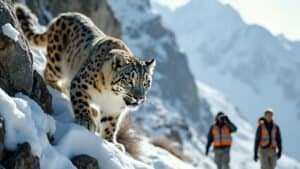Introduction
Tracking snow leopards in the wild is a complex task that involves cutting-edge technology and innovative methods. Scientists use GPS collars, camera traps, and even scat analysis to monitor these elusive big cats in their rugged, remote habitats
This article will explore the technologies used to track snow leopards, the challenges faced by researchers, and how the data collected is crucial for conservation efforts. We will also discuss the ethical considerations involved in tracking these endangered animals and highlight the key findings that have emerged from these studies
Tracking Technologies Used for Snow Leopards
Tracking snow leopards in the wild is an intricate process that relies on a combination of modern technology and traditional research methods
These elusive animals inhabit some of the most remote and rugged terrains on Earth, making it challenging for scientists to monitor their movements. However, advancements in tracking technologies have made it possible to gather critical data about their behavior, population size, and habitat use
GPS Collars: How They Work
One of the most effective tools in tracking snow leopards is the GPS collar. These collars are equipped with a Global Positioning System (GPS) unit that records the animal’s location at regular intervals, typically every few hours
The data collected is then transmitted to researchers via satellite or GSM networks, allowing scientists to monitor the snow leopard’s movements in near real-time
The GPS collars are designed to be lightweight and durable, ensuring that they do not hinder the animal’s natural behavior. They are usually fitted during a short period when the snow leopard is sedated, often after being captured in a live trap or darted from a distance
The collar is programmed to release automatically after a set period, ensuring that the animal is not permanently burdened by the device
GPS tracking has revolutionized wildlife research, providing insights into snow leopard home ranges, hunting patterns, and interactions with other species
For example, a study conducted by the Snow Leopard Trust in Mongolia revealed that snow leopards can travel over 25 miles in a single night, covering vast territories in search of prey. This information is crucial for understanding the spatial needs of these predators and for developing effective conservation strategies
The Role of Camera Traps
Camera traps are another vital tool in snow leopard research. These remote cameras are strategically placed along trails, ridgelines, and other areas where snow leopards are likely to pass. Equipped with motion sensors, camera traps automatically capture images or videos when an animal moves within range
Camera traps provide a non-invasive way to monitor snow leopard populations and behaviors. Unlike GPS collars, which require capturing and handling the animal, camera traps can be set up and left in the field for extended periods, often months at a time
They are particularly useful for documenting the presence of snow leopards in areas where direct observation is nearly impossible due to the harsh terrain and elusive nature of the species
Images and videos captured by camera traps offer valuable data on snow leopard activity patterns, social interactions, and even physical health. By identifying individual leopards through their unique spot patterns, researchers can estimate population sizes and track changes over time
For instance, camera trap studies in the Himalayas have provided some of the first concrete evidence of snow leopard cub survival rates and mother-cub interactions, information that is critical for understanding population dynamics
Scat Analysis in Snow Leopard Research
While GPS collars and camera traps provide direct observations, scat analysis offers an indirect yet highly informative method for studying snow leopards. Scat, or feces, can be collected from the field and analyzed in a laboratory to determine various aspects of the snow leopard’s diet, health, and even genetic makeup
Through DNA analysis of scat samples, scientists can identify individual snow leopards and assess genetic diversity within populations
This is particularly important for understanding the connectivity between different snow leopard populations, which is vital for maintaining genetic health and resilience against environmental changes
Scat analysis also provides insights into the diet of snow leopards. By examining undigested prey remains and DNA in the scat, researchers can determine what the leopards are eating, how frequently they hunt, and their prey preferences
This information helps conservationists understand the predator-prey dynamics in different regions and can inform strategies to protect both the snow leopards and their prey species
In combination, GPS collars, camera traps, and scat analysis form a comprehensive approach to studying snow leopards in the wild. These technologies enable scientists to gather data that would be otherwise impossible to obtain, providing a deeper understanding of the species and informing conservation efforts to protect these magnificent big cats in their natural habitats
Challenges in Tracking Snow Leopards
Tracking snow leopards presents numerous challenges due to the species’ elusive nature and the harsh environments they inhabit
Researchers must overcome a variety of obstacles, from difficult terrain to ethical concerns, to effectively monitor these endangered cats. Understanding these challenges is crucial for improving tracking methods and ensuring the success of conservation efforts
Terrain and Weather Difficulties
Snow leopards are native to some of the most remote and rugged regions on the planet, including the mountainous areas of Central and South Asia
These terrains are characterized by steep slopes, deep valleys, and high altitudes, often exceeding 16,000 feet above sea level. The extreme topography poses significant logistical challenges for researchers attempting to track and study these animals
In addition to the challenging terrain, weather conditions in snow leopard habitats are often harsh and unpredictable. Researchers must contend with heavy snowfall, subzero temperatures, and sudden storms, which can impede access to study sites and damage tracking equipment
The combination of difficult terrain and severe weather not only makes it hard to physically reach snow leopard territories but also increases the risks associated with fieldwork
To mitigate these challenges, researchers often rely on local guides who are familiar with the landscape and the behavior of snow leopards
Despite this assistance, the physical demands of working in such environments can limit the amount of time researchers can spend in the field, thus reducing the amount of data that can be collected
Limited Access to Remote Areas
Snow leopard habitats are often located in politically and geographically remote regions, making access to these areas a significant challenge
In many cases, the best snow leopard habitats are found in countries with limited infrastructure, where roads and other forms of transportation are sparse. This limited access can delay research efforts and make it difficult to establish long-term monitoring programs
Moreover, the presence of international borders within snow leopard ranges adds another layer of complexity. The species’ habitat spans several countries, including China, India, Mongolia, Nepal, and Pakistan, each with its own set of regulations and political considerations
Researchers must navigate these cross-border issues, often requiring permits and cooperation from multiple governments, which can be time-consuming and bureaucratically challenging
Furthermore, some of these regions are affected by political instability or conflict, further complicating access and making fieldwork potentially dangerous. These geopolitical challenges necessitate careful planning and coordination among international conservation organizations, local governments, and communities to ensure safe and effective research operations
Ethical Considerations in Tracking
While tracking snow leopards is essential for understanding and conserving the species, it raises several ethical considerations. One of the primary concerns is the potential stress and harm that capture and collaring can cause to the animals
Although GPS collars are designed to be as non-invasive as possible, the process of capturing a snow leopard, whether by live traps or darting, can be stressful and pose risks to the animal’s health
To address these concerns, researchers follow strict ethical guidelines and protocols when handling snow leopards. This includes minimizing the time the animal is sedated, ensuring the collars are lightweight and do not interfere with the leopard’s normal activities, and using collars that are programmed to release after a certain period
Despite these precautions, the process still involves inherent risks, and researchers must constantly weigh the benefits of the data obtained against the potential impacts on the animals
Another ethical issue involves the use of camera traps. While non-invasive, camera traps can raise concerns about the privacy of both wildlife and local communities
In some cases, the placement of camera traps might inadvertently capture images of people, raising questions about consent and the use of these images. Researchers must be mindful of these ethical considerations and work closely with local communities to ensure that their research methods are culturally sensitive and respectful
The ethical challenges extend beyond the fieldwork itself to the broader implications of the research. The data collected from tracking snow leopards can have significant conservation impacts, but it also raises questions about how this information is used and shared. For example, revealing the exact locations of snow leopards could inadvertently lead to increased poaching risks
Therefore, researchers must carefully manage and protect the data they collect to ensure that it serves the best interests of the species and the communities that live alongside them
The challenges of tracking snow leopards are multifaceted, involving physical, logistical, and ethical considerations. Overcoming these obstacles requires a combination of innovative technology, collaboration with local communities, and a deep commitment to ethical research practices
Despite these challenges, the information gained from tracking snow leopards is invaluable for understanding their behavior, ecology, and the threats they face, ultimately contributing to the conservation of this iconic species
The Impact of Snow Leopard Tracking on Conservation
The ability to track snow leopards has significantly enhanced conservation efforts by providing critical data on their behavior, habitat use, and population dynamics
This information is essential for developing effective strategies to protect this endangered species and ensure their long-term survival in the wild
How Data Is Utilized for Conservation
The data collected from tracking snow leopards, particularly through GPS collars and camera traps, plays a crucial role in conservation planning
By understanding the movement patterns of snow leopards, scientists can identify critical habitats, such as key hunting grounds, denning sites, and migration corridors. This information allows conservationists to prioritize areas for protection and management, ensuring that the most important habitats are preserved
For example, GPS data has revealed that snow leopards require vast territories to thrive, often spanning hundreds of square miles. This knowledge has prompted conservation organizations to advocate for the creation of larger, connected protected areas that can accommodate the spatial needs of these big cats
In regions where snow leopard habitats overlap with human settlements or livestock grazing areas, tracking data has been used to develop conflict mitigation strategies, such as establishing predator-proof livestock pens and promoting sustainable herding practices
Additionally, tracking data helps identify the threats snow leopards face, such as habitat fragmentation, poaching, and climate change. By monitoring the movements of individual leopards, researchers can detect changes in behavior that may indicate increased stress or risk, allowing for timely interventions
For instance, if a snow leopard’s movements suggest it is avoiding certain areas due to human activity, conservationists can work with local communities to reduce disturbances or create buffer zones to minimize human-wildlife conflict
Collaborations with Local Communities
Successful snow leopard conservation relies heavily on the involvement of local communities, who are often the first line of defense against poaching and habitat degradation. Tracking data is frequently shared with these communities to raise awareness about the importance of snow leopards and to foster a sense of stewardship over their natural resources
In many snow leopard range countries, community-based conservation programs have been established, where local residents participate in monitoring efforts, such as maintaining camera traps or reporting sightings
These programs not only provide valuable data but also create economic opportunities through eco-tourism and conservation jobs, incentivizing the protection of snow leopards
For example, in Kyrgyzstan, the Snow Leopard Trust has partnered with local herders to create a program called “Snow Leopard Enterprises,” where communities produce and sell handicrafts with a portion of the proceeds supporting snow leopard conservation
The program encourages herders to protect snow leopards and their prey by providing them with an alternative income source that is directly linked to the presence of these big cats in their environment
Local knowledge also plays a critical role in tracking snow leopards. Indigenous and local communities often have a deep understanding of the landscape and wildlife, which can be invaluable for identifying snow leopard habitats and movement patterns. Collaborating with these communities ensures that conservation strategies are culturally appropriate and more likely to succeed in the long term
Key Findings from Tracking Studies
Tracking snow leopards has led to several key findings that have reshaped our understanding of these elusive cats and their conservation needs. One of the most significant discoveries is the extent of their home ranges, which are much larger than previously thought
This insight has underscored the importance of landscape-scale conservation approaches that go beyond individual protected areas and focus on maintaining connectivity across large regions
Another important finding is the variation in snow leopard behavior across different parts of their range. For instance, in areas with high prey density, snow leopards tend to have smaller home ranges and more stable territories, while in regions with lower prey availability, they must travel greater distances to find food
These behavioral differences highlight the need for tailored conservation strategies that address the specific challenges faced by snow leopards in different environments
Tracking studies have also provided valuable information on snow leopard reproduction and cub survival rates, which are crucial for understanding population dynamics. Camera trap data, in particular, has revealed that snow leopards have relatively low reproductive rates, with females typically giving birth to one or two cubs every two years
This slow reproductive rate, combined with high cub mortality in some areas, makes snow leopard populations especially vulnerable to threats like poaching and habitat loss
The integration of tracking data with genetic studies has further enhanced conservation efforts by identifying critical genetic corridors that connect isolated snow leopard populations. Maintaining these corridors is essential for ensuring genetic diversity and the long-term viability of snow leopards across their range
Tracking snow leopards has had a profound impact on conservation by providing the data needed to protect these animals effectively
From identifying critical habitats to fostering community involvement and uncovering key behavioral patterns, tracking technologies have become indispensable tools in the fight to save the snow leopard. As conservationists continue to refine their methods and expand their collaborations with local communities, the future of the snow leopard looks increasingly hopeful
Conclusion
Tracking snow leopards in the wild has transformed our understanding of these elusive and endangered cats. Through the use of GPS collars, camera traps, and scat analysis, scientists have gained invaluable insights into snow leopard behavior, habitat use, and population dynamics
Despite the significant challenges posed by harsh terrains, extreme weather, and ethical considerations, these technologies have provided critical data that is essential for conservation efforts
Collaborations with local communities and the integration of tracking data into conservation strategies have further enhanced the effectiveness of these efforts. As a result, the ongoing research and conservation initiatives offer hope for the long-term survival of snow leopards in their natural habitats







